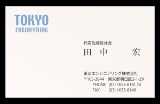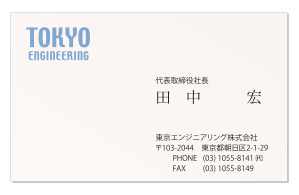
Meishi
Encyclopedia

Japan
Japan is an island nation in East Asia. Located in the Pacific Ocean, it lies to the east of the Sea of Japan, China, North Korea, South Korea and Russia, stretching from the Sea of Okhotsk in the north to the East China Sea and Taiwan in the south...
ese business card
Business card
Business cards are cards bearing business information about a company or individual. They are shared during formal introductions as a convenience and a memory aid. A business card typically includes the giver's name, company affiliation and contact information such as street addresses, telephone...
. The presentation of one's meishi to another person is more formal and ritualistic than in the west
Western world
The Western world, also known as the West and the Occident , is a term referring to the countries of Western Europe , the countries of the Americas, as well all countries of Northern and Central Europe, Australia and New Zealand...
.
Presentation
A person is expected to present their meishi upon meeting a new business acquaintance. Meishi should be kept in a smart leather case where they will not become warm or worn, both of which are considered a sign of disrespect or thoughtlessness. The presenter extends the meishi, holding it with both hands, and introduces themselves by affiliation, position, and name. The card should be held at the bottom two corners, face up and turned so that it can be read by the person receiving the meishi.When receiving a meishi, one should hold it at the top two corners using both hands. Placing one's fingers over the name or other information is considered rude. Upon receiving the meishi, one is expected to read the card over, noting the person's name and rank. One should then thank the other person, saying "choudai itashimasu" or "choudai shimasu", and then bow. A received meishi should not be written on or placed in a pocket; it is considered proper to file the meishi at the rear of the leather case. When meishi are being exchanged between parties with different status
Social status
In sociology or anthropology, social status is the honor or prestige attached to one's position in society . It may also refer to a rank or position that one holds in a group, for example son or daughter, playmate, pupil, etc....
, such as between the president of a company and someone in middle management, it is proper that the person of lower status extend his or her business card in such a way that it is underneath or below the meishi being extended by the person in a higher position. If the meishi is being presented at a table, the meishi you received is kept on top of your leather case until you leave the table. If several people are involved in the meeting and you have several meishi, the one with the highest rank is kept on the leather case, and the others beside it, on the table.
The manner in which the recipient treats the presenter's meishi is indicative of how the recipient will treat the presenter. Actions such as folding the business card in half, or placing the presenter's meishi in one's back pocket, are regarded as insults.
Appearance
Meishi give the most importance to the company and not the person's name. For example, meishi will feature the company name at the top in the largest print, followed by the job title and then the name. This is also the order in which Japanese introduce themselves; by their company and title first.Usually the person's name is written in Japanese
Japanese language
is a language spoken by over 130 million people in Japan and in Japanese emigrant communities. It is a member of the Japonic language family, which has a number of proposed relationships with other languages, none of which has gained wide acceptance among historical linguists .Japanese is an...
using both Chinese
Kanji
Kanji are the adopted logographic Chinese characters hanzi that are used in the modern Japanese writing system along with hiragana , katakana , Indo Arabic numerals, and the occasional use of the Latin alphabet...
and Latin characters
Romanization of Japanese
The romanization of Japanese is the application of the Latin alphabet to write the Japanese language. This method of writing is known as , less strictly romaji, literally "Roman letters", sometimes incorrectly transliterated as romanji or rōmanji. There are several different romanization systems...
, along with the person's title and the company for which he or she works. Typically, the Chinese characters are printed on the obverse of the card, and the Latin on the reverse. Other important contact information is usually provided, such as business address, phone number and fax number.
Meishi may also contain a QR code
QR code
A QR code is a type of matrix barcode first designed for the automotive industry. More recently, the system has become popular outside of the industry due to its fast readability and comparatively large storage capacity. The code consists of black modules arranged in a square pattern on a white...
to provide contact details in a machine-readable form, but this has not yet become a widespread practice. According to a 2007 survey, fewer than 3% of Japanese people own a meishi with a QR code printed on it.
A Japanese executive or official usually has two business cards; one, in Japanese, used Japanese order and is intended for fellow Japanese. The other, with the name in Western order, is intended for foreigners.
Dimensions
Traditionally, meishi are produced in an old Japanese paper size called yon-gō(4号, 91×55 mm), although the equivalent metricatedMetrication
Metrication refers to the introduction and use of the SI metric system, the international standard for physical measurements. This has involved a long process of independent and systematic conversions of countries from various local systems of weights and measures. Metrication began in France in...
size of 90×55 mm is also gaining popularity. It was once customary to use cards of a smaller size called sangō (3号; 85×49 mm) with rounded corners for women's meishi, but this size is no longer common.
External links
- Meishi: The Art of Introductions. Review of a 2007 exhibition of meishi at the Printing Museum, Tokyo, with photographs.
- Meishi: Japanese Business Card Exchange, Translation & Etiquette. Cultural Tips on the Etiquette of Exchanging Business Cards in Japan and information on Japanese business card translation.
- Japanese Business Card Samples. Exchanging business cards in Japanese culture and business card translation and printing.
- Japanese Business Card Translation Samples. Examples of western-based English business cards translated and typeset into bilingual Japanese meishi.

